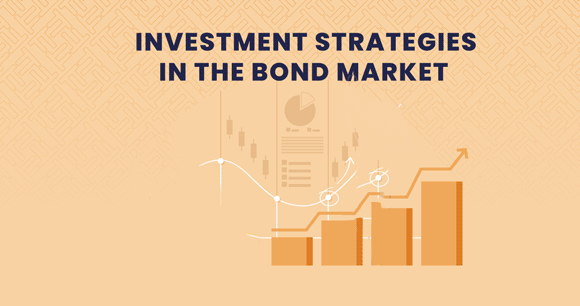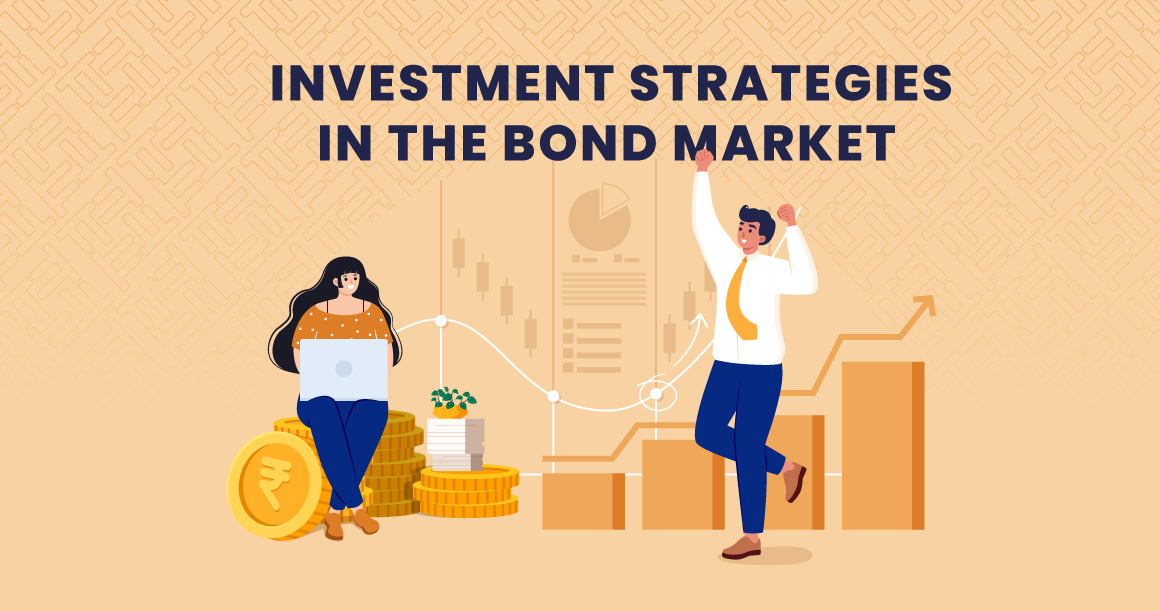Bond investment strategies range from a buy-and-hold method to intricate tactical trades using predictions of inflation and interest rates. The best investing strategy for one would depend on their goals, time frame, and level of risk tolerance, just like with any other type of investment.
WHAT IS A BOND INVESTMENT STRATEGY?
The management of a bond portfolio is known as a bond strategy. It aims to either improve returns in response to anticipated changes in certain bond-pricing elements or to preserve a specific return despite changes in those factors.
IMPORTANCE OF BOND INVESTMENT STRATEGIES
Recall the significance of diversification when thinking about a bond investment plan. It’s seldom a smart idea to concentrate all of the assets and risks in a single asset class or investment, as a general rule. By building a portfolio of numerous bonds, each with distinct features, one will wish to diversify the risks involved in their bond investments. One is protected from the danger that any one issuer won’t be able to fulfill its obligations to pay interest and principal by selecting bonds from various issuers. The diversification of bonds (government, agency, corporate, municipal, mortgage-backed securities, etc.) provides security against potential losses in any one market sector. Investors can reduce interest rate risk by selecting bonds with various maturities.

When compared to, say, selecting 1 or 2 bond funds, investing in individual bonds can frequently necessitate a more strategic and knowledgeable approach, but there are special advantages for those willing to put in the work. If one can construct a plan that works for them, a portfolio of individual bonds can offer investors a constant, reliable income due to their scheduled interest payments and established maturity dates.
Think about these distinct goals and methods for reaching them in light of that.
STRATEGIES TO MANAGE BOND PORTFOLIO
When it comes to building a bond portfolio, there are numerous strategies available, and each strategy has its own risk and reward tradeoffs. The following are the main approaches used to manage bond portfolios:
- Passive, or “buy and hold”
- Index matching, or “quasi-passive”
- Barbell Strategy
- Immunization, or “hybrid”
1. PASSIVE BOND MANAGEMENT STRATEGY
A passive investing approach, often known as a buy-and-hold investment strategy, tries to maximise returns by holding investments until maturity. A passive investor seeks to maximise returns without having to worry about the direction that interest rates and the value of bonds will take in the future because bonds have a predictable character. On the bond’s maturity, the entire coupon amount is paid out at par. The passive investment plan is a fantastic technique to guarantee income stability during difficult economic times. All costs, including transaction charges, are eliminated.
Bond laddering is one of the most popular passive investment strategies.
1.1 WHAT IS A BOND LADDER?
Building a portfolio with bonds or other fixed income assets that mature constantly at evenly spaced intervals is known as building a bond ladder. The investments are carried through to the finish as the bonds nearest to maturity expire. The investor’s position of holding bonds with equally spaced maturities is maintained as a result. Using this approach, one can increase average returns while lowering liquidity and interest rate risk.

Consider purchasing 4 bonds with maturities of 2, 4, 7, and 10 years. You reinvest the proceeds into a 10-year bond as each bond matures and pays back your principle. These long-term bonds generally have higher interest rates. More significantly, you’ve produced a diverse maturity distribution because no two bonds mature at the same time.
CASH FLOWS FROM THE LADDER

What is the relationship between bond prices and interest rates?
WHO ADOPTS THIS STRATEGY?
Ladders are popular among bond investors with long-term goals, such as putting money aside for college expenses. They’re also quite helpful for retirees and other people looking to establish a steady income. However, laddering can necessitate a significant long-term commitment of resources, and no bond’s principal repayment at maturity is certain.
ADVANTAGES:
- Additional investment flexibility is provided by the periodic return of principal.
- If interest rates are quite high, further bonds can be purchased with the proceeds, or if rates are relatively low, other securities can be purchased with the proceeds of principle and interest payments.
- Your bond portfolio is now dispersed across various coupons and maturities, reducing your exposure to interest rate volatility.
2. MATCHING BOND MANAGEMENT STRATEGY
The goal of an indexing approach is to build a portfolio that can provide returns like a selected bond index. The inventors invest in particular bond indices, such as the aggregate bond index from Barclays Capital. Total returns across the investment horizon serve as a gauge for the bond index’s performance. By using an indexing method, investors may manage their bond portfolio and have more control over their investments. Additionally, it assists investors in removing the possibility of subpar bond management performance. The purchase and hold investment approach is comparable to indexing, although indexing offers greater flexibility.
There are numerous methods to implement indexing

2.1 PURE BOND INDEXING-
Simply purchasing all of the bonds that make up the index in the same ratios is known as pure bond indexing (also known as the full replication strategy). However, since some indexes are made up of thousands of bonds, it could be expensive to completely replicate an index, particularly for thinly traded bonds that might have wide bid/ask spreads. Many bond managers use a subset of the index to overcome this issue, however, the subset might not precisely track the index, resulting in tracking error.

2.2 CELL MATCHING STRATEGY-
The index is divided into distinct groups with a certain duration, credit rating, sector, and so on. The bonds with the characteristics of each cell are then purchased as part of a cell matching approach, which is sometimes used to avoid or minimise tracking error. Additionally, the number of bonds chosen for each cell might reflect the ratios in the bond index.

Advantages
- A matching strategy would entail the deliberate acquisition of securities that would periodically pay dividends and interest.
- Possibility to adjust portfolios with general or specific bond exposures
- Low cost index investments reduce portfolio costs.
- Index investing provides you access to thousands of bonds in a single trade.
3. BARBELL STRATEGY
Buying solely short- and long-term bonds is part of a barbell approach. This gives you the best of both worlds, in theory. Longer-term bonds allow you to lock in higher interest rates, whereas shorter-term securities provide you more freedom to invest in other assets if interest rates drop too low to generate enough income. The short-term bonds can be retained until maturity and then reinvested at the higher current interest rates if rates should rise.
Example: You purchase two long-term bonds to benefit from the high long-term interest rates. Additionally, you purchase two short-term bonds concurrently. When the short-term bonds mature and you receive the principle, you can choose how to invest it: in more bonds if interest rates are high enough to produce adequate income, or in a more liquid shorter-term investment if you believe rates will increase shortly. In the meantime, you continue to get interest payments from the two longer-term bonds with greater yields.

Advantages:
- The strategy allows you to take advantage of rates when they’re high, without limiting your financial flexibility.
- Because a portion of your assets is invested in securities that mature every few years, you have the necessary liquidity to make large purchases or respond to emergencies.
- Allocating only part of your fixed-income portfolio to longer-term bonds can help reduce the risk associated with rising rates, which tend to have a greater impact on the value of longer maturities.
4. IMMUNIZATION BOND MANAGEMENT STRATEGY
Also known as length matching strategy, immunization is a blend of active and passive investment tactics. It helps in removing the danger of changing interest rates by matching the length of the portfolio to the investor’s investment horizon. This strategy focuses on achieving the needed level of return by making investments with the intention of earning a specific amount by the end of a specific time.
Bonds have both interest-rate risk and reinvestment risk, which share an inverse relationship to each other. When one increases, the other decreases. Interest rate risk increases with an increase in rates, whereas reinvestment risk decreases. Bond prices rise as interest rates fall, but the bonds’ cash flows can only be reinvested at a lower rate without assuming greater risk. Cash flow matching has the drawback that, if bonds are held until maturity, any reinvestment risk cannot be compensated by higher bond prices.
Hence reinvestment is necessary. For instance, Rs 1000 placed in a savings account that yields 6% compounded semi-annually would yield Rs 806.11 after 10 years, whereas a 6% coupon bond with a par value of Rs 1000 would yield only Rs. 600 after 10 years. Therefore, to earn a 6% return with a coupon bond, the coupon must be reinvested.
4.1 CLASSICAL IMMUNIZATION
Classical immunisation entails building a bond portfolio so that it will generate a minimal return independent of fluctuations in interest rates. A few conditions must be met for the immunisation method to work, including: no defaults; asset prices must only fluctuate in response to interest rates (bonds, for example, cannot include embedded options); and yield curve shifts must be parallel.
4.2 CONTINGENT IMMUNIZATION
An immunised bond portfolio is used to guarantee a minimum return whereas contingent immunisation incorporates active management of a small amount of invested money, which may allow for higher returns.
The investor-acceptable goal rate for the immunised portion of the portfolio is the lowest possible return that is equivalent to the market rate. The cushion spread, also known as extra attainable return, is the difference between the return rates of a partially immunised portfolio and a fully immunised portfolio with the remaining portion being actively managed.
CONCLUSION
Bond investments carry hazards, but the aforementioned tactics can help reduce those risks while still maximising rewards. Based on your investment horizon, investment volume, and risk tolerance, you may choose the best bond portfolio management plan for you. A passive or vaccination strategy is a choice if your risk tolerance is very low, whereas an index matching or immunisation strategy would be preferable if your risk tolerance is more moderate.
How does inflation affect bond price?
FAQ’S on Investment Strategies
Should I buy bonds when interest rates are rising?
The interest rate on a bond is set when it’s issued, so if you buy a bond today, you’ll lock in that rate for the life of the bond. That means that if rates continue to rise, your bond will actually become more valuable, since it will provide a higher rate of return than new bonds being issued at the higher rates.
What does the market price of a bond depend on?
The market price of a bond depends on a number of factors, including the current interest rate, the bond’s coupon rate, its maturity date, and the creditworthiness of the issuer. In general, bonds with higher coupons and shorter maturities will have higher prices than those with lower coupons and longer maturities. This is because investors require a higher rate of return to compensate for the greater risk associated with these bonds.
What happens to bonds if stock market crashes?
If the stock market crashes, the prices of bonds will usually go up. This is because when the stock market is going down, investors are looking for a place to put their money where it will be safe, and bonds are one of the safest investments. However, there are some types of bonds, such as junk bonds, that may go down in price if the stock market crashes.






